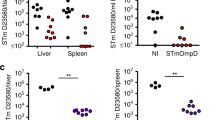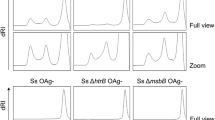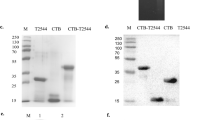Abstract
We have developed a recombinant live oral vaccine using the ice-nucleation protein (Inp) from Pseudomonas syringae to display viral antigens on the surface of Salmonella spp. Fusion proteins containing viral antigens were expressed in the oral vaccine strain, Salmonella typhi Ty21a. Surface localization was verified by immunoblotting and fluorescence-activated cell sorting. The immunogenicity of surface-displayed viral antigens on the recombinant live vaccine strain was assessed in mice inoculated intranasally and intraperitoneally. Inoculation resulted in significantly higher serum antibody level than those induced by viral antigens expressed intracellularly. Thus, this multivalent mucosal live vaccine may provide an effective means for inducing mucosal or systemic immune responses against multiple viral antigens.
This is a preview of subscription content, access via your institution
Access options
Subscribe to this journal
Receive 12 print issues and online access
$209.00 per year
only $17.42 per issue
Buy this article
- Purchase on Springer Link
- Instant access to full article PDF
Prices may be subject to local taxes which are calculated during checkout





Similar content being viewed by others
References
Georgiou, G. et al. Display of heterologous proteins on the surface of microorganisms: from the screening of combinational libraries to live recombinant vaccines. Nat. Biotechnol. 15, 29–34 (1997).
O'Callaghan, D. et al. Immunogenicity of foreign peptide epitopes expressed in bacterial envelope proteins. Res. Microbiol. 141, 963–969 (1998).
Curtiss, R. et al. Antigen delivery systems for analysing host immune responses and for vaccine development. Trends Biotechnol. 8, 237–240 (1990).
Roberts, M., Chatfield, S.N. & Dougan, G. In Novel delivery systems for oral vaccines. (eds O'Hagan, D.T.) 27–58 (CRC Press, Inc., New York 1994).
Hofnung, M. Expression of foreign polypeptides at the Escherichia coli cell surface. Methods Cell Biol. 34, 77–105 (1991).
Charbit, A., Molla, A., Saurin, W. & Hofnung, M. Versatility of a vector for expressing foreign polypeptides at the surface of Gram-negative bacteria. Gene 70, 181–189 (1988).
Jung, H.C., Lebeault, J.M. & Pan, J.G. Surface display of Zymomonas mobils levansucrase by using the ice-nucleation protein of Pseudomonas syringae. Nat. Biotechnol. 16, 576–560 (1998).
Kozloff, L.M., Turner, M.A. & Arellano, F. Formation of bacterial membrane ice-nucleating lipoglycoprotein complexes. J. Bacteriol. 173, 6528–6536 (1991).
Green, R.L., Corotto, L.V. & Warren, G.J. Deletion mutagenesis of the ice nucleation gene from Pseudomonas syringae S203. Mol. Gen. Genet. 215, 165–172 (1988).
Wolber, P.K. Bacterial ice nucleation. Adv. Microb. Physiol. 34, 203–235 (1993).
Nemecek-Marshall, M., LaDuca, R. & Fall, R. High level expression of ice nuclei in a Pseudomonas syringae strain is induced by nutrient limitation and low temperature. J. Bacteriol. 175, 4062–4070 (1993).
Jung, H.C., Park, J.H., Park, S.H., Lebeault, J.M. & Pan, J.G. Expression of carboxymethylcellulase on the surface of Escherichia coli using Pseudomonas syringae ice nucleation protein. Enzyme Microb. Technol. 22, 348–354 (1998).
Cardenas, L. & Clements, J.D. Oral immunization using live attenuated Salmonella spp. as carriers of foreign antigens. Clin. Microbiol. Rev. 5, 328–342 (1992).
Sousa, C., Cebolla, A. & de Lorenzo, V. Enhanced metalloadsorption of bacterial cells displaying poly-His peptides. Nat. Biotechnol. 14, 1017–1020 (1996).
Agterberg, M., Adriaanse, H., van Bruggen, A., Karperien, M. & Tommassen, J. Outer membrane PhoE protein of Escherichia coli K-12 as an exposure vector: possibilities and limitations. Gene 88, 37–45 (1990).
Agterberg, M., Adriaanse, H., Barteling, S., van Maanen, K. & Tommassen, J. Protection of guinea-pigs against foot-and-mouth disease virus by immunization with a PhoE–FMDV hybrid protein. Vaccine 8, 438–440 (1990).
Wong, R.S.Y., Wirtz, R.A. & Hancock, R.E.W. Pseudomonas aeruginosa outer membrane protein OprF as an expression vector for foreign epitopes: the effects of positioning and length on the antigenicity of the epitope. Gene 158, 55–60 (1995).
Laukkanen, M.-L., Teeri, T.T. & Keinanen, K. Lipid-tagged antibodies: bacterial expression and characterization of a lipoprotein–single-chain antibody fusion protein. Protein Engineer. 6, 449–454 (1993).
Cornelis, P. et al. Development of new cloning vectors for the production of immunogenic outermembrane fusion proteins in Escherichia coli. Bio/Techology 14, 203–208 (1996).
Georgiou, G. et al. Display of β-lactamase on the Escherichia coli surface: outer membrane phenotypes conferred by Lpp'-OmpA'—lactamase fusions. Protein Engineer. 9, 239–247 (1996).
Chen, G., Cloud, J., Georgiou, G. & Iverson, B.L. A quantitative immunoassay utilizing Escherichia coli cells possessing surface-exposed single chain Fv molecules. Biotechnol. Progr. 12, 572–574 (1996).
Suzuki, T., Lett, M.-C. & Sasakawa, C. Extracellular transport of VirG protein in Shigella. J. Biol. Chem. 270, 30874–30880 (1995).
Lu, Z. et al. Expression of thioredoxin random peptide libraries on the Escherichia coli cell surface as functional fusions to flagellin: a system designed for exploring protein–protein interactions. Bio/Technology 13, 366–372 (1995).
Pallesen, L., Poulsen, L.K., Christiansen, G. & Klemm, P. Chimeric FimH adhesin of type 1 fimbriae: a bacterial surface display system for heterologous sequences. Microbiology 141, 2839–2848 (1995).
Newton, S.M.C. et al. Expression and immunogenicity of an 18-residue epitope of HIV1 gp41 inserted in the flagellar protein of Salmonella live vaccine. Res. Microbiol. 146, 203–216 (1995).
Kornacker, M.G. & Pugsley, A.P. The normally periplasmic enzyme β-lactamase is specifically and efficiently translocated through the Escherichia. coli outer membrane when it is fused to the cell-surface enzyme pullulanase. Mol. Microbiol. 4, 1101–1109 (1990).
Chabalgoity, J.A., Khan, C.M.A., Nash, A.A. & Hormaeche, C.E. A Salmonella typhimurium htrA live vaccine expressing multiple copies of a peptide comprising amino acids 8–23 of herpes simplex virus glycoprotein D as a genetic fusion to tetanus toxin fragment C protects mice from herpes simplex virus infection. Mol. Microbiol. 19, 791–801 (1996).
Hone, D.M. et al. Optimization of live oral Salmonella–HIV-1 vaccine vectors for the induction of HIV-specific mucosal and systemic immune responses. J. Biotechnol. 44, 203–207 (1996).
McGhee, J.R. et al. The mucosal immune system: from fundamental concepts to vaccine development. Vaccine 10, 75–88 (1992).
Leclerc, C., Charbit, A., Molla, A. & Hofnung, M. Antibody response to a foreign epitope expressed at the surface of recombinant bacteria: importance of the route of immunization. Vaccine 7, 242–248 (1989).
Dunn, M., Al-Ramadi, B.K., Barthold, S.-W., Flavell, R.A. & Fikrig, E. Oral vaccination with an attenuated Salmonella typhimurium strain expressing Borrelia burgdorferi OspA prevents murine Lyme Borreliosis. Infect. Immun. 63, 1611–1614 (1995).
Su, G.-F., Brahmbhatt, H.N., Wehland, J., Rohde, M. & Timmis, K.N. Construction of stable LamB-Shiga toxin B subunit hybrids: analysis of expression in Salmonella typhimurium aroA strains and stimulation of B subunit-specific mucosal and serum antibody responses. Infect. Immun. 60, 3345–3359 (1992).
Schorr, J., Knapp, B., Hundt, E., Küpper, H.A. & Amman, E. Surface expression of malarial antigens in Salmonella typhimurium: Induction of serum antibody response upon oral vaccination of mice. Vaccine 9, 675–681 (1991).
Barry, E.M. et al. Expression and immunogenicity of pertussis toxin S1 subunit-tetanus toxin fragment C fusions in Salmonella typhi vaccine strain CVD908. Infect. Immun. 64, 4172–4181 (1996).
Galen, J.E. et al. A murine model of intranasal immunization to assess the immunogenicity of attenuated Salmonella typhi live vector vaccines in stimulating serum antibody responses to expressed foreign antigens. Vaccine 15, 700–708 (1997).
O'Callaghan, D., Maskell, D., Liew, F.Y., Easmon, C.S.F. & Dougan, G. Characterization of aromatic-dependent and purine-dependent Salmonella typhimurium: studies on attenuation, persistence, and ability to induce protective immunity in BALB/c mice. Infect. Immun. 56, 419–423 (1988).
Maurer, J., Jose, J. & Meyer, T.F. Autodisplay: one-component system for efficient surface display and release of soluble recombinant proteins from Escherichia coli. J. Bacteriol. 179, 794–804 (1997).
Pohlner, J., Halter, R., Beyreuther, K. & Meyer, T.F. Gene structure and extracellular secretion of Neisseria gonorrhoeae IgA protease. Nature 325, 458–462 (1987).
Acknowledgements
This work was supported in part by grant NRI 2000 from MOST (Ministry of Science and Technology) and grant BSKP1011 from KRIBB (Korea Research Institute of Bioscience and Biotechnology) of Korea. We thank Dr. S.A. Shin, Dr. H.C. Jung, and Dr. M.H. Sung for technical help and continuous encouragement during this work, and Dr. K. Shimotohno (National Cancer Center Research Institute, Japan) for a generous gift of p740 cDNA plasmid.
Author information
Authors and Affiliations
Corresponding author
Rights and permissions
About this article
Cite this article
Lee, JS., Shin, KS., Pan, JG. et al. Surface-displayed viral antigens on Salmonella carrier vaccine. Nat Biotechnol 18, 645–648 (2000). https://doi.org/10.1038/76494
Received:
Accepted:
Issue Date:
DOI: https://doi.org/10.1038/76494
This article is cited by
-
Yeast display platform technology to prepare oral vaccine against lethal H7N9 virus challenge in mice
Microbial Cell Factories (2020)
-
An Effective Platform for Exploring Rotavirus Receptors by Bacterial Surface Display System
Virologica Sinica (2020)
-
Construction of a bacterial surface display system based on outer membrane protein F
Microbial Cell Factories (2019)
-
Engineered microbial biosensors based on bacterial two-component systems as synthetic biotechnology platforms in bioremediation and biorefinery
Microbial Cell Factories (2017)
-
Cell surface protein engineering for high-performance whole-cell catalysts
Frontiers of Chemical Science and Engineering (2017)



